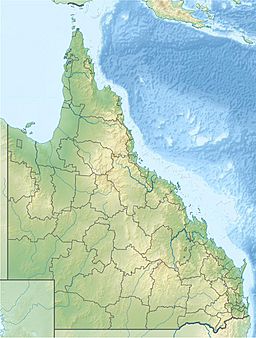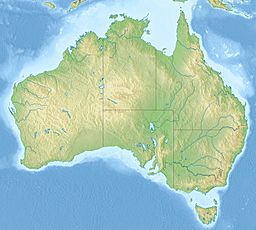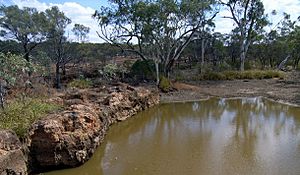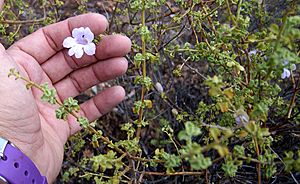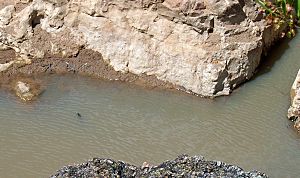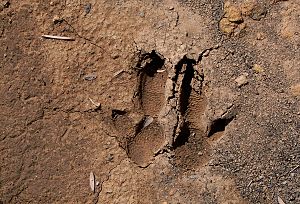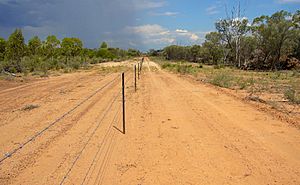Yapunyah waterhole facts for kids
Quick facts for kids Yapunyah Waterhole |
|
|---|---|
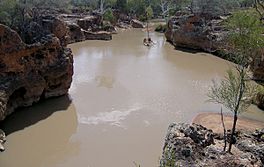
The waterhole in 2011
|
|
| Location | South West Queensland |
| Coordinates | 25°29′08″S 144°18′43″E / 25.48556°S 144.31194°E |
| Lake type | Permanent waterhole |
| Primary inflows | Nutting Creek |
| Catchment area | Barcoo River |
| Basin countries | Lake Eyre Basin, Australia |
| Max. length | 2 km (1.2 mi) |
| Surface area | 22 ha (54 acres) |
The Yapunyah Waterhole is a special place in western Queensland, Australia. It's located in an area called the Mulga Lands. This waterhole is about two kilometres long and covers an area of 22 hectares when it's full.
What makes Yapunyah Waterhole so unique? It's a permanent waterhole. This means it almost never dries up, even in very dry regions. Permanent waterholes are super rare in this part of Australia. They are like oases for plants and animals, giving them a safe place to live and find water. For thousands of years, these waterholes were also very important for Aboriginal people, providing food, water, and spiritual meaning.
Today, the waterhole is on a cattle farm. The owners are working hard to protect the amazing plants and animals that live there. They also want to preserve the important cultural history of the area. They work with a local group called Desert Channels Queensland to help with this important work.
Yapunyah Waterhole is part of the Cooper Creek system and the huge Lake Eyre Basin. It sits in the Grey Range between the towns of Adavale and Yaraka in South West Queensland. The waterhole gets its water from Nutting Creek. This creek flows into Powell Creek, which then goes through Hell Hole Gorge National Park and eventually into the Barcoo River. The area around the waterhole is covered in mulga Acacia aneura trees. Even though it's a dry area with little rain, the waterhole stays full!
Contents
Why is Yapunyah Waterhole Permanent?
Permanent waterholes are very unusual in dry places like the Lake Eyre Basin. These rare waterholes are super important. They are like safe havens for aquatic animals and plants, especially during droughts. Rivers in this area often dry up, becoming just a series of waterholes. These waterholes only flow when there's heavy rain, usually in summer.
Animals that can't survive drying out, like most fish and some macroinvertebrates, depend on these waterholes. The Cooper Creek Turtle and the water rat also need permanent water. These waterholes also provide homes for land mammals, reptiles, frogs, and birds that need water or hollow trees to live.
Permanent waterholes usually have more different types of species than waterholes that dry up. They offer a stable home in a changing environment. When rivers shrink to just a few waterholes during dry times, it shows how important and fragile these places are.
Here are the main reasons why Yapunyah Waterhole stays full:
- The bottom of the waterhole is rocky, which helps it hold water.
- The land around it is steep. This makes the waterhole deeper when it rains a lot. The steep, rocky land also protects it from strong, drying winds.
- Rainwater from the nearby hard ground flows into the waterhole, topping it up even during smaller rain events in the dry season.
- People don't use the water for homes because it's in a remote and hard-to-reach spot.
Amazing Habitats at Yapunyah
The rocks, ledges, and areas along the water's edge at Yapunyah Waterhole create many different homes for native plants and animals. These include the vulnerable yellow-footed rock wallaby and the unique Cooper Creek Turtle.
Yapunyah Waterhole is a very healthy place. There are no signs of introduced fish, cane toads, or harmful weeds. It's full of native wildlife and offers a safe place for species to survive dry periods.
Plants of Yapunyah Waterhole
The main type of tree around the rocky edges of the waterhole and Nutting Creek is the mulga Acacia aneura woodland. Other plants found near the water include:
- River red gum E. camaldulensis
- Ghost gum Corymbia aparrerinja
- Bendee Acacia calendulata
- Lancewood Acacia shirleyi
- Narrow-leafed hop bush Dodonaea viscosa var angustissima
- Different types of Thryptomenes (like Grampians, hook-leaf, and rock Thryptomene sp.)
- Inland spur-flower Plectranthus intraterraneus
- Mint bush Prostanthera megacalyx
- Red ash Alphitonia excelsa
Two plant species found here, Quinine bush Petalostigma pubescens and Reed grass Arundinella nepalensis, usually grow further east. This makes their presence at Yapunyah Waterhole quite special!
Animals of Yapunyah Waterhole
Cooper Creek Turtle: Life Cycle and Habitat
The Cooper Creek Turtle Emydura macquarii emmottii lives only in the Lake Eyre Basin. It's a short-necked turtle and one of Australia's largest side-necked turtles. These turtles can weigh up to eight kilograms and grow over 40 centimetres long!
Adult turtles are often found in large numbers in permanent waterholes. Younger turtles are more common in waterholes that sometimes dry up. Waterholes that dry up completely usually don't have any turtles. You can often see adult turtles swimming and popping their heads up at Yapunyah Waterhole.
Yellow-footed Rock Wallaby: Habitat and Protection
The yellow-footed rock wallaby Petrogale xanthopus is a special type of wallaby found only in Queensland. It lives in rugged, rocky areas between Adavale, Blackall, and Stonehenge. These wallabies live in several groups in national parks like Idalia, Welford, and Hell Hole Gorge, and also on private land like the "Bulloo Lakes" station.
The rocky ledges and overhangs at Yapunyah Waterhole provide a perfect home for yellow-footed rock wallabies. They are often seen drinking there. The yellow-footed rock wallaby is considered a vulnerable species, meaning it needs protection to survive.
Fish of the Waterhole
Permanent waterholes are super important for fish in south-western Queensland. They are vital for several fish species found only in this region. These include:
- Lake Eyre yellow belly (Macquaria sp.)
- Cooper Creek tandan (Neosilurus sp.)
- Hardy heads (Craterocephalus sp.)
- Gudgeons (Hypseleotris sp.)
Fish found in the nearby Nutting Creek include:
- Spangled perch (Leiopotherapon unicolour)
- Bony bream (Nematalosa erebi)
- Desert rainbow fish (Melanotaenia splendida tatei)
Other aquatic animals living here are freshwater prawns (Macrobrachium australiense) and Blue Claw yabbies (Cherax destructor).
Cultural Heritage: Aboriginal Connections
For thousands of years, permanent and semi-permanent waterholes in dry areas were incredibly important to Aboriginal people. Rivers and creeks were like natural pathways for people to travel. Reliable waterholes were vital stops along these routes.
Because they were so valuable, waterholes were also rich in stories and beliefs. They were seen as places that provided both spiritual and physical nourishment. Evidence suggests that Yapunyah Waterhole was a very important place for Aboriginal people. It likely provided food, bush medicines, water, and materials for making stone tools.
With help from Indigenous communities, the current owners of the property are working to protect this important waterhole for the future.
Protecting Yapunyah Waterhole
It's important to protect the delicate wetlands in this region. Landowners, like those at "Bulloo Lakes" Station, are taking steps to do just that.
One way they protect the area is by increasing plant cover and keeping livestock away from the creek areas. This helps to stabilize the environment and protect the wetlands. At Yapunyah Waterhole, they built many kilometres of fences around the waterhole and parts of Nutting and Powell Creeks. This fencing stops cattle from entering these sensitive areas. They also moved watering points for cattle to better manage grazing.
These fencing projects have helped protect thousands of hectares of land, including the waterhole and the plants along the creeks. With the fences in place, the land managers can completely keep livestock out of Yapunyah and Kokanah Waterholes and nearby creek areas.
To keep the waterhole protected, the owners also:
- Keep livestock out of the fenced area (except for fire management).
- Maintain the new fences.
- Check the watering points regularly.
- Monitor the waterhole and creek areas every year.
- Record sightings of wallaby species.
- Have plans to manage fire and pests.
Desert Channels Queensland, a local group, helped fund some of the fencing projects. The owners of a neighbouring station, "Gooyeah," also helped. These projects have made it easier to manage the land while protecting these fragile areas and conserving an important ecosystem for native plants and animals.
While you can't visit Yapunyah Waterhole, the owners of "Bulloo Lakes" Station want other landowners and locals to learn about and respect the area's natural and cultural heritage. They have even hosted study trips to share how they manage this special wetland. They are keen to hear from anyone genuinely interested in helping to protect this unique and mostly untouched area.


